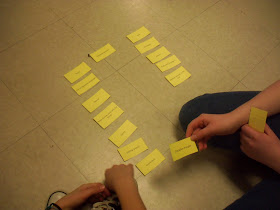As the year draws to a close, I find myself teaching more and more about comparing texts. This is the perfect topic for the end of the year, as we have so much shared history and shared readings.
Why do we compare texts? Sometimes the process of comparing helps us to think more deeply about texts, finding details that we didn't know were there. And sometimes the process helps us to see how texts that seem quite different have many things in common, and how there are common themes and ideas that come up again and again in literature. For my fourth graders, just starting to think at a higher level, comparing texts is a great way to open up their thinking about the great world of literature.
Here are some things that I've learned can really help kids to compare texts effectively.
Share lots of high quality books: The books that I read over the last few weeks for inferring work perfectly for comparing. When kids have read a variety of books that share common themes, the task of comparing is easier--and lots more fun.
Teach students to generate criteria: I started my lesson by showing kids a terribly written paragraph that compared two stories based on insignificant criteria--the number of words in the title, the number of letters in the character's names, etc. Students recognized right away that this paragraph was pretty silly! Then, I gave students cards with different criteria written on them. They sorted the cards based on "significant" or "not significant". For example, "genre" is significant, while "use of the letter r" is not. (Kids appreciated this one!) Some, like "animals in the text" could go either way--it depends on what is being compared.
We ended up sorting the cards three times over the next week, reviewing what made the different criteria significant or not. The students had so many experiences with looking at how texts can be compared that they easily came up with significant criteria on their own.
Make it a game! If you use a Texts We've Shared Wall, start off a conversation by asking kids to browse the wall and look for two texts that would be easy to compare. Why? Then, look for two texts that would be very hard to compare. Why are these two so different? Can anyone find any significant similarities? This task helps kids to think more flexibly about comparing texts, looking at it as a fun challenge instead of a chore.
Put transition words in front of students: Give students the words they need to write compare and contrast text. Words like on the other hand, however, both, also, similar, and different...these words make comparing and contrasting infinitely easier. A page with different compare and contrast transition words will help students to write better paragraphs.
Weave in the editing: This is the perfect time to address finer points of which titles get quotation marks and which get underlined. Because students will be going back and forth between talking about the different texts, they have a real reason to use this punctuation.
Comparing texts is a great end of year activity...and it can be lots of fun!


No comments:
Post a Comment